1 + 1 = a lot of laughs
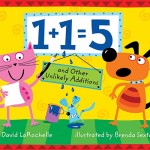 Any kindergartner at this time of year will quickly tell you that 1 + 1 = 2, unless it’s a kindergartner who has read this fantastic book 1 + 1 = 5 and Other Unlikely Additions by David LaRochelle and illustrated by Brenda Sexton. The lucky kid who’s read this book knows that 1 + 1 can = 3 if we’re talking about the horns of 1 unicorn + 1 goat. 1 + 1 = 5 if we’re talking about babies (1 set of twins + 1 set of triplets). When does 1 + 1 = hundreds? When we’re counting the seeds in 1 pumpkin + 1 watermelon, a task that would be fun to try with your class after reading this book. Each equation will get kids thinking of combinations of sets in new ways. Challenge your students to write their own 1 + 1 = stumper. Fold a piece of paper in half lengthwise (or hot-dog-wise if you visualize it that way). Set it up so the fold is on top, like a lift-the-flap. Have students write 1 + 1 = and their unexpected number. Lift the flap and show how 1 set of things + 1 set = the combination. Your students will have a ball stumping each other and their parents. 1 great book + 1 class of cool kids = plenty of learning for them and a lot of fun for you.
Any kindergartner at this time of year will quickly tell you that 1 + 1 = 2, unless it’s a kindergartner who has read this fantastic book 1 + 1 = 5 and Other Unlikely Additions by David LaRochelle and illustrated by Brenda Sexton. The lucky kid who’s read this book knows that 1 + 1 can = 3 if we’re talking about the horns of 1 unicorn + 1 goat. 1 + 1 = 5 if we’re talking about babies (1 set of twins + 1 set of triplets). When does 1 + 1 = hundreds? When we’re counting the seeds in 1 pumpkin + 1 watermelon, a task that would be fun to try with your class after reading this book. Each equation will get kids thinking of combinations of sets in new ways. Challenge your students to write their own 1 + 1 = stumper. Fold a piece of paper in half lengthwise (or hot-dog-wise if you visualize it that way). Set it up so the fold is on top, like a lift-the-flap. Have students write 1 + 1 = and their unexpected number. Lift the flap and show how 1 set of things + 1 set = the combination. Your students will have a ball stumping each other and their parents. 1 great book + 1 class of cool kids = plenty of learning for them and a lot of fun for you.
Go Bananas!
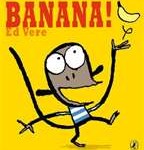 Want a book that every kid in your class can read with expression and enjoyment? Try Ed Vere’s nearly wordless picture book, Banana! I love using wordless and nearly wordless books with young readers. (If you want the myriad of reasons why wordless books are great for building narrative skills, fluency, top-down processing, etc., check out this article by the Center for the Improvement of Early Reading Achievement or this one from Education Week.) The facial expressions on the two monkeys are so engaging, and the text is limited to two words: banana and please with either question marks or exclamation points. Read it aloud once to your little ones, and they’ll be begging to read it on their own. Use it as a lesson on punctuation and how it changes the way we read words on the page. Take two monkey puppets or make monkey masks and let the kids act out the story – even better if you bring in real bananas!
Want a book that every kid in your class can read with expression and enjoyment? Try Ed Vere’s nearly wordless picture book, Banana! I love using wordless and nearly wordless books with young readers. (If you want the myriad of reasons why wordless books are great for building narrative skills, fluency, top-down processing, etc., check out this article by the Center for the Improvement of Early Reading Achievement or this one from Education Week.) The facial expressions on the two monkeys are so engaging, and the text is limited to two words: banana and please with either question marks or exclamation points. Read it aloud once to your little ones, and they’ll be begging to read it on their own. Use it as a lesson on punctuation and how it changes the way we read words on the page. Take two monkey puppets or make monkey masks and let the kids act out the story – even better if you bring in real bananas!
A Place for Wonder
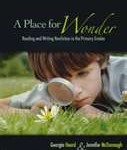 Usually I write about children’s books, but this week I’m sharing a gem for grown-ups recommended by my friend, Annemarie Johnson. (Annemarie is a gifted teacher and educational consultant, and her website: http://www.teacher2teacherhelp.com is bursting with great information.) I’ve been thinking quite a bit about nonfiction, so with the school year winding down and summer months opening up some time for me to read professional development books, I’m reading A Place of Wonder: Reading and Writing Nonfiction in the Primary Grades by Georgia Heard and Jennifer McDonough. I love the idea of creating a “wonder center” with treasures like pine cones and rocks kids bring in plus plastic magnifying glasses and informational books and paper to draw and record observations. Even the suggestion of stocking classroom shelves with more nonfiction picture books and having students decide how the books should be sorted makes sense to me. If you have great nonfiction books you use with your young students, please feel free to share in the comments what works for you. This summer, I will read and wonder, plan and share.
Usually I write about children’s books, but this week I’m sharing a gem for grown-ups recommended by my friend, Annemarie Johnson. (Annemarie is a gifted teacher and educational consultant, and her website: http://www.teacher2teacherhelp.com is bursting with great information.) I’ve been thinking quite a bit about nonfiction, so with the school year winding down and summer months opening up some time for me to read professional development books, I’m reading A Place of Wonder: Reading and Writing Nonfiction in the Primary Grades by Georgia Heard and Jennifer McDonough. I love the idea of creating a “wonder center” with treasures like pine cones and rocks kids bring in plus plastic magnifying glasses and informational books and paper to draw and record observations. Even the suggestion of stocking classroom shelves with more nonfiction picture books and having students decide how the books should be sorted makes sense to me. If you have great nonfiction books you use with your young students, please feel free to share in the comments what works for you. This summer, I will read and wonder, plan and share.
Chew on these great books
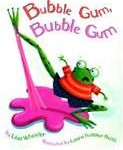 In a recent Remenar Seminar, a principal pointed out that I share lots of stories, but not a lot of non-fiction. That’s something I’m working on – I love fiction, but I know many learners really respond to informational text. So, I’m trying to pair up books on irresistible topics – like bubble gum!
In a recent Remenar Seminar, a principal pointed out that I share lots of stories, but not a lot of non-fiction. That’s something I’m working on – I love fiction, but I know many learners really respond to informational text. So, I’m trying to pair up books on irresistible topics – like bubble gum!
I’m stuck on the bouncy rhyme of Lisa Wheeler’s Bubble Gum, Bubble Gum: “chewy-gooey bubble gum/ icky-sticky bubble gum/ melting in the road/ along comes a toad” who gets stuck. Then a shrew gets stuck, and more animals get stuck – until a truck comes along! What will they do? Chew! And blow a bubble that lifts them from danger, until…
This makes a terrific storybox. Put this book, with its great illustrations by Laura Huliska-Beith, and puppet characters on wooden sticks in the storybox with a container of homemade pink playdough (make sure it’s non-toxic because one of your sweetpeas will probably try chewing on it) to retell the story.
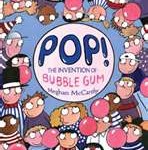 Then, share Pop! The Invention of Bubble Gum by Megan McCarthy. It is excellent non-fiction for younger students. The topic is sure to grab their attention, the text is short but interesting and full of fun facts, and the illustrations are large enough for a group read. At the end of the book, McCarthy adds lots more information (like who holds the world record for largest bubble) for kids who want to really sink their teeth into the subject.
Then, share Pop! The Invention of Bubble Gum by Megan McCarthy. It is excellent non-fiction for younger students. The topic is sure to grab their attention, the text is short but interesting and full of fun facts, and the illustrations are large enough for a group read. At the end of the book, McCarthy adds lots more information (like who holds the world record for largest bubble) for kids who want to really sink their teeth into the subject.
Want a super-duper Dubble Bubble science extension? Ask your students, “Do you think bubble gum will weigh more or less after you chew it?” Use the scientific method of forming a hypothesis, listing materials and procedure, controlling variables (everyone chews the same kind of gum for the same amount of time), and see what your results are!
Read MorePlant some new ideas
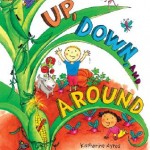 Spring has finally arrived, even in Michigan, and many of us are pulling out plant and garden books. Here’s a good one to add to your bunch: Up, Down and Around by Katherine Ayers and Nadine Bernard Westcott. In this book, kids learn that some things grow up, like corn and broccoli, some things grow down, like carrots and potatoes, and some things grow around, like pumpkin vines and green beans. You can talk about prepositions and location words, making a fun center with seed packets and magnets. (Being the frugal fanatic, I’ve started collecting free magnets from pizza parlors and real estate offices, cutting them up and hot-gluing them to pictures I want to use on magnetic boards. And did you know that cookie sheets are magnetic and make great little portable retelling boards? Cool, huh?) So, hot-glue magnets to the backs of seed packets and let kids sort them by what grows above or below ground on cookie sheets labeled “above” and “below”. If you have a green thumb, plant fun veggies like green beans and let kids ooh over the curling vines. And, if you are like me, the Dr. Kevorkian of the plant world, do a simpler experiment: Bring in potatoes, point out the “eyes”, and leave them in paper bags for a couple of weeks to see if they’ll sprout! Tie this book in with Tops and Bottoms by Janet Stevens, or pair it with non-fiction books like The Vegetables We Eat by Gail Gibbons. Hooray for spring!
Spring has finally arrived, even in Michigan, and many of us are pulling out plant and garden books. Here’s a good one to add to your bunch: Up, Down and Around by Katherine Ayers and Nadine Bernard Westcott. In this book, kids learn that some things grow up, like corn and broccoli, some things grow down, like carrots and potatoes, and some things grow around, like pumpkin vines and green beans. You can talk about prepositions and location words, making a fun center with seed packets and magnets. (Being the frugal fanatic, I’ve started collecting free magnets from pizza parlors and real estate offices, cutting them up and hot-gluing them to pictures I want to use on magnetic boards. And did you know that cookie sheets are magnetic and make great little portable retelling boards? Cool, huh?) So, hot-glue magnets to the backs of seed packets and let kids sort them by what grows above or below ground on cookie sheets labeled “above” and “below”. If you have a green thumb, plant fun veggies like green beans and let kids ooh over the curling vines. And, if you are like me, the Dr. Kevorkian of the plant world, do a simpler experiment: Bring in potatoes, point out the “eyes”, and leave them in paper bags for a couple of weeks to see if they’ll sprout! Tie this book in with Tops and Bottoms by Janet Stevens, or pair it with non-fiction books like The Vegetables We Eat by Gail Gibbons. Hooray for spring!
The Red Hen
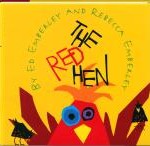 This is the kind of book that’s perfect for readers’ theater, a Storybox, or the dramatic play area. It has a straight-forward plot, few characters, and easy dialogue. The Red Hen by Rebecca Emberley and Ed Emberley is a bright retelling of the classic folktale. This version is way less wordy than some I have seen (and not used). The Red Hen wants to make a cake, but the cat, the rat, and the frog don’t want to help. Every time the Red Hen asks for assistance, the answer is the same:
This is the kind of book that’s perfect for readers’ theater, a Storybox, or the dramatic play area. It has a straight-forward plot, few characters, and easy dialogue. The Red Hen by Rebecca Emberley and Ed Emberley is a bright retelling of the classic folktale. This version is way less wordy than some I have seen (and not used). The Red Hen wants to make a cake, but the cat, the rat, and the frog don’t want to help. Every time the Red Hen asks for assistance, the answer is the same:
‘Not I,’ said the cat.
‘Not I,’ said the rat.
‘Bribbit,’ said the frog.”
Of course, Red Hen is undaunted. “I will do it myself.” And in the end, when the cake is ready to be eaten, Red Hen does that herself, too. I like this version better than some I have seen because the text is short enough for my youngest listeners but the folktale we’re all familiar with has been preserved. The art is large and bold in typical Emberley style, so it works for a group read-aloud. After one reading, all your little ones will chime in with cat, rat, frog and hen. Put this in a Storybox or a dramatic play area with puppets or masks to build those narrative retelling skills, and if you’re feeling culinary like Red Hen, make the recipe included on the last pages. Just be sure you don’t have to make the cake all by yourself.
Read More
Why Nursery Rhymes Work
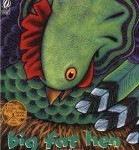 I had the pleasure of attending a kindergarten “family night” at an elementary school. The theme was nursery rhymes, and once again I was reminded why these rhymes are so powerful. I could (and often do) go on for days about the phonological awareness that rhyme builds, how children who are read to are exposed to thousands more words than those who hear only daily conversation and television, how we learn words best in meaningful context and how the rich language of nursery rhymes develops a child’s vocabulary, but I know I’m preaching to the choir. Instead, allow me to share with you one of my favorite nursery rhyme books, Big Fat Hen by Keith Baker. This is my go-to nursery rhyme book for littlest listeners, and all my students who are building number recognition feel like rock stars because they can read this so easily. The pictures are huge, perfect for a group share, and the text is quickly read to wiggly ones.
I had the pleasure of attending a kindergarten “family night” at an elementary school. The theme was nursery rhymes, and once again I was reminded why these rhymes are so powerful. I could (and often do) go on for days about the phonological awareness that rhyme builds, how children who are read to are exposed to thousands more words than those who hear only daily conversation and television, how we learn words best in meaningful context and how the rich language of nursery rhymes develops a child’s vocabulary, but I know I’m preaching to the choir. Instead, allow me to share with you one of my favorite nursery rhyme books, Big Fat Hen by Keith Baker. This is my go-to nursery rhyme book for littlest listeners, and all my students who are building number recognition feel like rock stars because they can read this so easily. The pictures are huge, perfect for a group share, and the text is quickly read to wiggly ones.
One of the best parts of the kindergarten family night for me was seeing how successful the students felt as they read nursery rhymes to me from books and off of posters. Because of the short, rhyming text, nursery rhymes are easily memorized, so those who are still developing word recognition and decoding skills can feel successful as they “read” from memory the rhymes. I brought a pretend candlestick (a toilet paper tube wrapped in construction paper with a red tissue paper flame which is as crafty as I get) and had students act out “Jack Be Nimble” after we read the rhyme. Amazingly fun and super-easy, make a poster of the rhyme, have 3×5 cards with your students’ names to tape up over the word “Jack”, and let your little ones be part of the rhyme.
Read More








